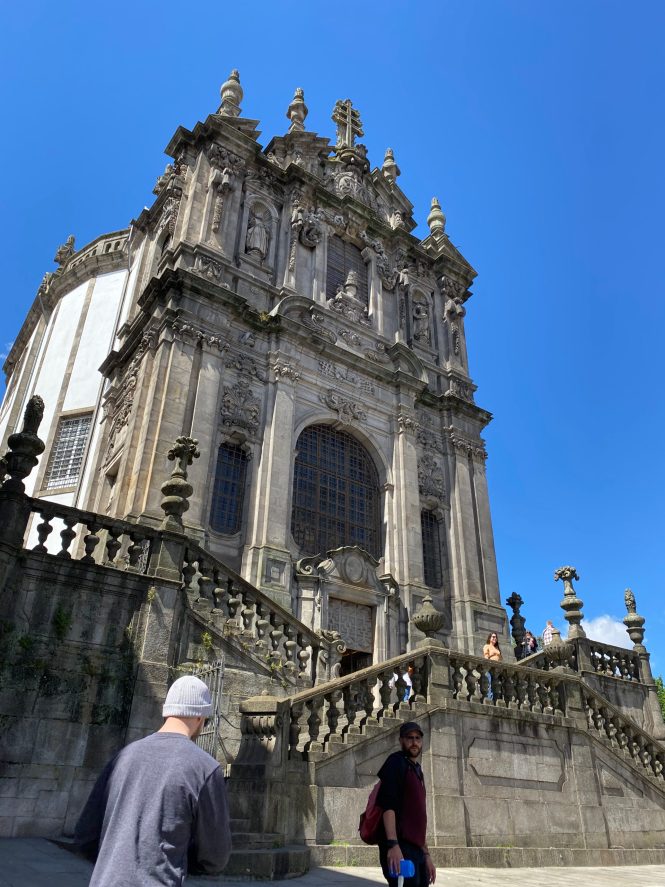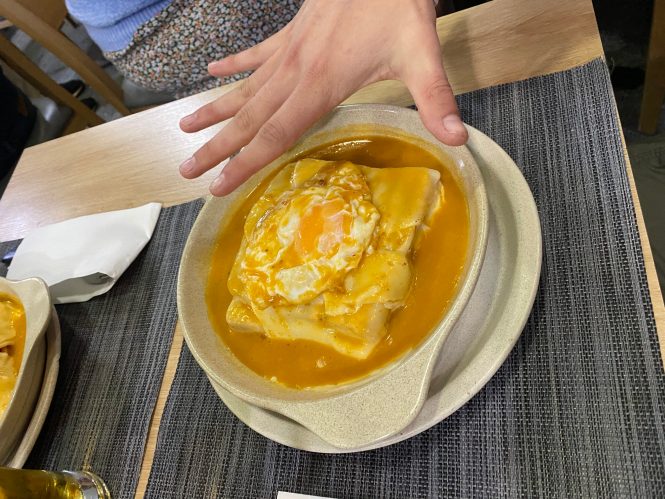One of my favorite things about travel is stepping off an airplane and into a place where all the sights, sounds, and smells are unfamiliar. It’s kind of like ascending the first hump of a roller coaster. I’m excited and scared about what’s going to happen next.
Of course, it’s not until right at this moment I remember how this analogy breaks down when it comes to family travel. The arrival point is the funhouse-that’s-not-actually-fun part of the carnival, and for us it typically includes one kid who’s mad at me for “doing it wrong” (this trip: the way I rode an escalator), another who’s sulking and hangry, and an argument about which train stop will take us closest to our hotel, followed by a kilometer of dragging too-heavy suitcases over wonky cobblestones to lodging we won’t have access to for an indeterminate period of time.

Throw in a very near miss by about seven pounds of sea gull poop, and you’ve got the gist of the first half of our first day in Portugal.
Still, it’s hard to curb my enthusiasm. I’ve been excited for this trip for months.
In that time, we’ve gotten a lot of questions about “why Portugal?” I don’t know that we have a good answer except Mike got a lead on some decent tickets about six months ago and we were optimistic about the COVID situation and itching to travel.

Portugal holds a tremendous amount of historical interest for us, too. It played big role in world history, but one we’ve learned very little about until we sought out information on our own.
Portugal was a world power during Europe’s Age of Discovery, followed by a stint as one of Western Europe’s poorest countries in the 19th and 20th centuries. It’s enjoyed an uptick as a tourist destination in recent years and represents huge potential for retired expats.
With this, I mean to say absolutely nothing about our own plans that anyone should read anything into, ever.
Or maybe. I don’t know.
We decided to start our trip in Porto, the country’s second largest city and one of the most under-rated vacation destinations in western Europe. We’re staying in the Ribeira neighborhood, the 2,000-year-old UNESCO World Heritage center of town near the double decker Dom Louis I Bridge over the Douro River.
(you can actually see the windows of our flat in the photo above, just to the right of the tallest white building [the bishop’s palace] a little obscured by the smoke of the car fire that was happening just then near the riverside).
The whole area is a mixture of ruins and buildings in various states of refurbishment. We’re in a 2nd floor apartment of a seventeenth century manor house that has spectacular views of the river and bridge. The exterior rock walls are at least a foot thick and do an amazing job of keeping the sun out.




I’m pretty sure the place isn’t haunted, or if it is, it’s by very chilly ghosts who stick to the eighteen-inch warming radius of the space heaters placed high up on the walls of two of the back rooms. So, we’re good.
And, when I say 2nd floor, that’s actually what it is from the north side of the building (fun fact: In Europe it’s important to remember that the first floor is called the ground floor, the 2nd floor is the 1st floor and so on, before you accidentally try to force your way into what you think is your 3rd floor rented flat but is actually the 2nd floor apartment of some gal who’s just living her life wishing the upstairs neighbors would quit doing the Airbnb thing). From the south side of the building, by the river, we’re about 300 and some steps up, or about 20 flights.
Porto’s very hilly, by the way, and suffers from a lack of elevators.



After a good night’s sleep, we were able to rally early the second morning to take a tour from Tiago, a young local who makes a living guiding people up and down the stairs of Porto. It’s supposed to rain for much of this trip, but we had gorgeous weather for our tour.
One of my favorite things here is the blend of culture and history that’s visible everywhere. You can see it, for example, in the iconic blue and white (and sometimes yellow) tiles that decorate so many buildings. A holdover from the country’s 800-year Moor occupation, the tiles were found to be easy to maintain and good insulators, so they stayed. The more traditional geometric designs eschew human images in art–per Islamic tradition–which doesn’t appear to have kept them from gracing the sides of more than a few churches and cathedrals, where they were later adapted in design to accommodate Christian theology.



Many of the streets are narrow (some just inches wider than I can reach when I spread my arms). They’re also steep and lined with uneven cobblestones. The buildings are in various states of refurbishment, as I’ve said. If Tiago is to be believed, they remain populated mostly by locals, who were relocated amidst the uptick in urban renewal projects largely driven by tourism, and then moved back into the old town (charming, if true, but not a fact I’ve been able to confirm with my trademark 37-second Google search, although I did see a number of grey haired old ladies observing us from laundry-lined balconies as we toured).
We may only have hours of good weather left in this trip, so we spent the afternoon after our tour taking Tiago’s advice, first in choice of lunch venues, then by visiting the gold plated Igreja Monumento de São Francisco (I’ll post a link to the gold-plated Chapel of Saint Anthony, since photography is prohibited), then by doing our best to get lost in the maze of streets of old town Porto.





For dinner last night, we took another of Tiago’s suggestions, skipping the tourist traps near the river in favor of a restaurant on one of the narrow back streets. By 8 pm, every place we passed on the way had a line out the door, or else we might not have waited for a table at this little hole-in-the wall that, from the looks of the menu on the window, promised basic meat-and-potatoes comfort food that was going to work for each of us.
This comfort food included the traditional Portuguese sandwich the Francesinha, or “little Frenchy,” a sandwich of pork chop, ham, and sausage, baked with cheese and an over easy egg all covered with a spiced tomato and beer sauce.


Jack and I split one of these our first night, while Mike opted to try one on his own, which he couldn’t finish, much to his chagrin when our waitress noted “hey, I’m small, and even I could finish one.”
When we relayed this story to Tiago, he was unsympathetic. “Well, most 15-year-old girls around here can finish one of those. As a snack,” which is when we learned that Portuguese are into food shaming, and also that Mike is susceptible to double-dog-dares from tour guides when it comes to his gastro-fortitude compared to that of a 15-year-old girl.
Anyway, this night’s dinner was at the Casa Bragança, a spot recommended by Tiago about 10 minutes away from our apartment. The restaurant has space for exactly 20 people, but they appear to be willing to crowd in another 12 over that. We waited outside for at least an hour, which I wouldn’t have except the weather wasn’t terrible for waiting outside and there was a mild amount of drama which I am always up for as long as it doesn’t involve us.
That drama involved a young couple dining with their baby who was clearly NOT HAVING IT IN A BIG WAY in the small space. All the other diners pretended not to notice his screaming. At one point mom took a break from this drama to have a cigarette outside near us, which she lit with a butane lighter she’d borrowed from the restaurateur. She talked with us and playfully brandished the lighter at passersby in the narrow street, oblivious to her crying baby and her suffering two dozen or so co-diners left inside.
Turns out she’d just taken a 36-hour bus ride from Luxembourg to vacation in Porto with her boyfriend. At one point, said boyfriend poked his head out the door to tell her he didn’t appreciate the combination smoke-slash-talk break she was having and ordered her to return to help him with the baby.
He retreated and she rolled her eyes at us. “Jesus help me,” she said, and leisurely smoked the rest of her cigarette, oblivious to the irony of asking for sympathy from Jesus and by default also the 4 people who happened to be waiting for a 4-person table just like the one she was currently occupying with her 2.5-person family … in a restaurant filled with 32 people but made for 20 … while taking a smoke break … mid meal.
At some point the baby stopped screaming. Our new friend finished her cigarette and returned to her meal. A little later, baby daddy came out for his smoke break with his glass of wine. By this time another three people joined the line and then six people beyond that. Boyfriend didn’t chat us up but smoked and went back inside. We waited for a bit longer before the woman came out for her second cigarette and another chat.
“You’re still out here?” she asked.
Yes. Okay fine, at this point this woman had taken two cigarette breaks in the middle of her meal with a baby with whom she has spent the last 36 hours on a bus. Anyone who knows me would guess I was likely annoyed by this point.
But I wasn’t. I decided I loved her.
Who deserves a freaking smoke break, or probably two, more than a mom who has just spent 36 hours on a bus with a baby? Here I was, standing and waiting for dinner with two kids I love more than life itself, but who have also put me through much more than just a couple hours screaming in a crowded restaurant over the course of the past few years, and who will likely turn into okay adults, but from moment to moment, that fact is not always completely a given.
Why haven’t I taken my due of mid-meal smoke breaks or the equivalent?
Short answer: I should have. I. Freaking. Should. Have.
Finally, we were able to get a table inside and Jack and Mike each ordered a Francesinha to prove to a waitress and a tour guide who weren’t even present that they’re manly enough to finish a traditional Portuguese sandwich roughly the size of a human head. They dug in as the young family finally make ready to exit.
On their way out the woman said she wished she could kiss me, but because there’s a pandemic, she settled with awkwardly stroking my hair. I wished her a good vacation with her boyfriend and her baby.
Who, in the end, really was better behaved and more content after a 36-hour bus ride than any of us was after 19 hours on airplanes.





3 comments
That’s a fun blog post, Beth! Thanks! We can’t wait for our pending adventure to begin!
That’s a great blog post Beth!! Thanks I enjoyed it immensely.